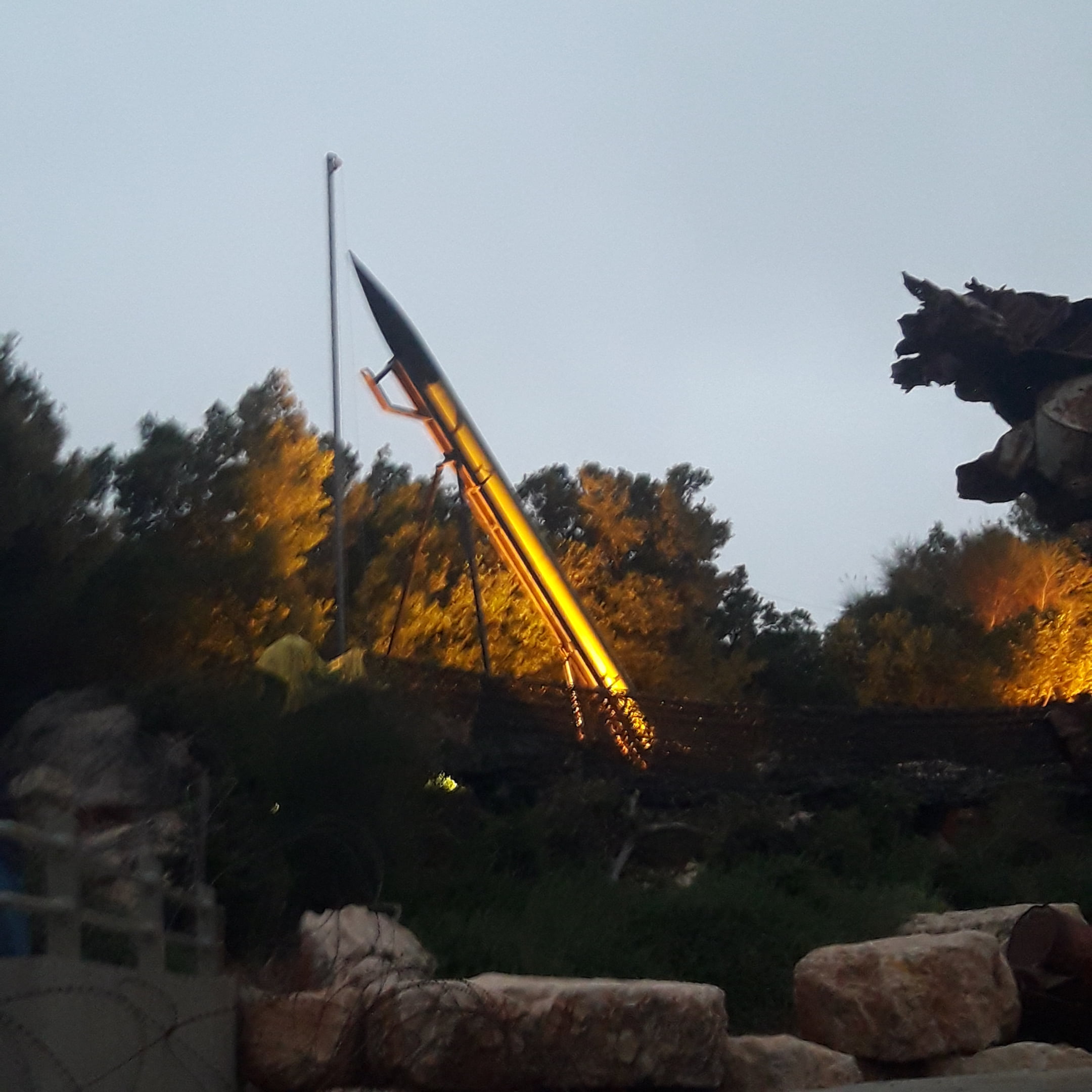
By Dr. Haytham Mouzahem -- On Aug. 19, Hezbollah gathered local and international media correspondents, The Levant News’ included, at the Tourist Landmark of the Resistance near Mleeta village in southern Lebanon, and presented three models of the Khaibar-1 rockets the party used during the July 2006 war. Hezbollah was able to target Israeli cities and towns over 50 kilometers away from the Lebanese border in response to Israel's targeting of civilians in Lebanese cities and villages.
This is the first time that Hezbollah shows a sample of these rockets that caught Israel off guard back in 2006. The party managed to target the city of Haifa and cities farther away, such as Hadera and Afula, with its unprecedented use of medium-range rockets launched from Lebanon at Israel. Hezbollah, as well as factions of the Palestine Liberation Organization (PLO), were known to use Katyusha rockets which only had a 20 to 22 kilometer range.
Before presenting the rockets that were added to the contents of the Hezbollah Museum in Mleeta, Sayyed Hashem Safieddine, head of Hezbollah’s Executive Council, delivered a short speech saying that “Hezbollah is now presenting a weapon used during the Zionist aggression in 2006. This is only one of the many surprises that allowed the party to win the war,” noting, “It is unlike the party to show weapons we did not actually use.”
On Aug. 10, on the anniversary of 2006 war, Hezbollah showed a number of its espionage drones, stressing that it was used previously. The Party said that it is its "Air Force" made by Hezbollah , which appears for the first time in Mleeta museum.
Safieddine then addressed media correspondents saying, “What you will see here is only the tip of the iceberg.”
The resistance has adopted a power strategy and proved its effectiveness in 2000 (trough the achievement of liberation of the South) and 2006 war, and continues to do so even until this very day. “The power we employ is to protect our countries and peoples. Today, there is no safety but the possession of power. There is no limit to the power we seek to possess in order to face an enemy possessing the ugliest and fiercest weapons that targeted villages, towns, people and children,” Safieddine said.
He added that Hezbollah’s power is constantly making strides to confront Israel’s maneuvers in the region at this critical stage. He noted that Hezbollah’s response has always been crystal clear; just as it won all its battles and defended the resistance axis in Lebanon, Syria and Palestine, the party will gear up and accept any challenge. However, Safieddine explained, “We never sought and will never seek war. We aim to protect and defend, and our experience has shown that this weapon has served its purpose.”
A source close to Hezbollah told The Levant News on condition of anonymity that it is no coincidence that the party revealed this weapon only five days after Hezbollah Secretary General Sayyed Hassan Nasrallah gave a speech, in which he confirmed that Hezbollah was stronger than the Israeli army. The party’s army was not the second strongest in the Middle East as Israelis try to promote, Nasrallah stressed, in response to Israeli maneuvers simulating a military confrontation with Hezbollah.
The source said that Safieddine’s statement about Hezbollah not seeking war is not a message of weakness and retreat, but rather an assertion that the resistance’s power is for defensive and deterrent reasons, which fought for confronting Israeli aggression and liberating Lebanese territory and the occupied land in the Shebaa farms, Kfarchouba and the village of Abbasiyah.
Meanwhile, Lebanese political analyst Abbas Sabbagh told The Levant News that Hezbollah presented the rockets it used during the July 2006 war as a way to stress the terror equation that Nasrallah declared on Aug. 14, commemorating the 12th anniversary of the party’s victory. Yet, a short while ago, Hezbollah introduced for the first time unmanned aerial vehicles as one of its means of power.
Sabbagh explained that showing these rockets further emphasizes that Hezbollah possesses more sophisticated rockets. Traditional armies and resistance movements reveal their strategic advantages only after a period of time and after acquiring new and more effective weapons.
Sabbagh said that Israelis are puzzled by the possibility of Hezbollah owning Russian-made surface-to-surface Yakhont missiles, dozens of which the Syrian army received from Russia in 2011. This poses a serious threat to the Israeli army, according to military experts, similarly to the Russian anti-tank Kornet missiles that arrived in Syria in 2004 and were used by Hezbollah in the 2006 war.
Hezbollah’s Khaibar-1 rockets had targeted the Israeli positions in Afula, 15 kilometers from the city of Haifa and 52 kilometers from the Lebanese border as well as positions in the town of Hadera, 75 kilometers from the Lebanese border.
Obviously, Hezbollah is sending political and military messages in response to Israel’s largest maneuvers this month since 1998, which aim to simulate a future war with the party that could break out on both the Lebanese and Syrian fronts. In addition, an upcoming war should take into account Hezbollah's developed military capabilities, as well as the experience it gained during the Syrian war and the quality weapons it accumulated since 2006.
According to Haaretz’ Amos Harel, Israel conducted one of the largest maneuvers in the history of the Israeli army with the purpose of simulating a comprehensive war against Hezbollah, so as “to send a deterrent message to Hezbollah.”
Harel said this maneuver reflects a number of changes on the northern border over the past decade, key of which is how developed Hezbollah’s capabilities have become and how many fighters it now has in Syria.
Yedioth Ahronoth reported that some figures in the Israeli army described Hezbollah as “the most powerful army in the Middle East after the Israeli army.”
The article read: “For the very first time, the Israeli ground forces are implementing a four-dimensional 'combined battle' strategy in preparation for a possible war with Hezbollah. Over the past few days, the IDF has been carrying out the most extensive training exercises conducted by the 36th Armored Division, including the 7th Armored Brigade. The "Gideon" battlgroup—a combat brigade that includes thousands of soldiers—is training in the Golan Heights for a possible conformation with the modern Hezbollah ... (which) is an army in every sense. It is advanced, fast, mobile and combative.”
The article added: “The Israeli army understands that Hezbollah has gained masses of experience in the civil war… Hezbollah now has new military capabilities, such as the ability to maneuver forces into enemy territory, drafting large forces in rapid speed, and more. It has received a new arsenal of weapons: special and high-quality night vision devices, electronic combat weapons, and hundreds of drones and UAVs, along with mortars carrying half a ton of explosives, and heavy rockets.”
The group was described by a senior officer in the Israeli Northern Command as "the strongest army in the Middle East after the IDF".
Hence, I believe that Hezbollah is showcasing some of its weapons to send a counter deterrent message to Israel following its intensive maneuvers, and Nasrallah’s declaration of the party being stronger than the Israeli army is based on linking between the Hezbollah’s military forces and the power of religious and metaphysical beliefs, not only for military and material reasons.
Translated by Cynthia Milan





